The Church of the Nativity has just released the third edition of its wonderful Old Orthodox Prayer Book with parallel English/Church Slavonic text. You can get a look at the new edition, including the improved font size, at the Church’s website here. As a longtime user of the second edition of the prayer book, I can’t recommend this spiritual resource enough. If you’ve never used this book before or, like me, have worn your second edition down, this is wonderful news.
11 Comments
Comments are closed.




April 26, 2016
Is this the same translation as the second edition? Some of the prayers to the Theotokos in the second edition drive me nuts.
April 26, 2016
I imagine they didn’t do too much in terms of translation differences. I just ordered mine, so I don’t know what the changes will be. The one thing I appreciate in the second edition is using “Mother of God” instead of “Theotokos,” unless it becomes redundant. It’s also one of the things I appreciate about the Fr. Lazarus Moore edition of the Jordanville Prayer Book.
April 27, 2016
They haven’t changed anything text-wise. It’s on better paper and easier to read though. I actually also prefer “Mother of God” to “Theotokos” but it seems that ship has sailed in Anglophone Orthodoxy.
April 27, 2016
“Theotokos” is rarely used in British Orthodoxy, I’m told, so it’s not anglophone Orthodoxy as a whole rather than just the U.S. (Not sure about Canada, Australia, etc.) Lacking as robust a high church tradition as in the UK, “Theotokos” would seem to have less the whiff of Rome for U.S. Protestants than “Mother of God” does. Reminded me of mention in a biography on Dorothy Day where she said something about not being able to kneel and pray because the stereotypical criticisms of ‘popery’ would overwhelm her, but she could pray the rosary while walking without the same distraction.
April 28, 2016
I think the preference for “Theotokos” has less to do with Romophobia and more to do with an inferiority complex felt vis-à-vis Greek as a theological language and also a tinge of exoticism.
April 28, 2016
Whose inferiority complex?
Protestants are typically quite impressed by Greek and tend to be allergic to things smacking too much of “Roman excess”, as they would put it. While orientalism/exoticism isn’t absent, I think the focus is more on Protestantism’s core focus on restorationism in various forms and movements. Russians never just took Theotokos into Slavonic directly, so it would seem the focus is more on newer American Orthodox communities. One might make a connection with the de-latinization of Carpatho-Rusyn converts, but their “russification” would have led them in the same direction as the Russians, I would presume.
To the potential Protestant convert to Orthodoxy, “Theotokos” in English doesn’t carry any baggage and has various upsides, at least psychologically and culturally. In the UK, “Mother of God” was as oft used by high church Anglicans as by Roman Catholics so I don’t think there was the same motivation for another option – even if they are effectively synonymous.
It’s interesting to me that such sleight of hand, almost euphemism, can allow pretty conservative (theologically) Protestants to consider, value, and convert to a more traditional, “Roman” position on Mary. Once “in”, they tend to have far greater appreciation and affinity for practices and teachings they would have scoffed at previously. Whlie there are any number of knee jerk, anti-Catholic voices in Orthodoxy (most especially online), this form of restorationism does more in the way of building bridges with Rome for Protestants than a great deal of ecumenical dialogue. Not that they are Catholic, want to be Catholic, or think the Catholic church is correct on any number of issues (right or wrong, fully informed or not), but Orthodoxy – and the euphemistic use of “Theotokos” – brings old time Protestants far closer to Rome than would have been the case otherwise.
April 30, 2016
I’ve used the 2nd Edition for a long time now as well as their Horologion and have to say that they are excellent, especially the Prayerbook. After having owned and used both the Jordanville and the HTM Prayerbook there’s no doubt in my mind that the Old Orthodox Prayerbook is the best of the bunch.
The Morning and Evening Prayers are roughly equal length; the rules for bows and prostrations are pretty straightforward; there is a calendar of saints and feasts with both the new style and old style dates, a paschalion through 2099, and there is the basic template for Matins through Vespers. It’s a workhorse. Did I mention it’s also got the Slavonic text on the opposite side of the page?
I’m curious about the 3rd edition, but must admit I’m still enjoying my 2nd Edition. I thought of just paying someone to put a nice sturdy leather cover on it for me. I like the size, both of the font and the book, and I prefer black to red but those aren’t huge issues really.
I’d also agree with those here that actually like Mother of God over Theotokos. It took awhile to get used to after the Jordanville but I like it better now, it’s less awkward.
May 2, 2016
Another cool thing about this book is that, as far as I know, it’s the only prayer book which includes St Joseph the Hymnographer’s beautiful Canon of the Akathist. My main problem with the 2nd edition was the poor quality paper it was printed on- it felt like newsprint. That’s rectified in the new edition.
May 3, 2016
Yeah I am on my second copy of the 2nd edition because the pages had badly yellowed on my original one after only a few years.
May 3, 2016
One thing I really liked about the OOPB is that it included the texts of the minor hours and the daily troparia/kontakia so that you could pray them “on the go.” I was always a little surprised they didn’t include the Lenten variants, though, especially since they wouldn’t add more than a few pages total to the book.
May 2, 2016
Incidentally, my own jurisdiction (ACROD) uses “Birthgiver of God.” At first I hated it as terribly awkward but I do appreciate that it gives a more-or-less direct translation immediately understandable to Anglophones.